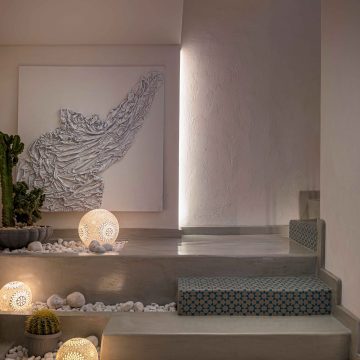Neocement
What is NEOCEMENT Decorative Finish?
- Easier to apply
- More color consistent
- Pre-tinted and pre-packaged
- Backed by a curated system of primers, topcoats and sealers
What is Microtopping?
Microtopping is a surface-coating technique that entails applying a thin layer of NEOCEMENT or other types of micro-cement on flooring, walls, countertops, and other surfaces. This creates a smooth, seamless, and aesthetically pleasing finish that is resistant to impact, abrasion, and the effects of the weather. Microtopping in Dubai, specifically, can help improve a structure’s resistance to ultraviolet radiation. Apply to various types of substrates, including concrete, tiles, and wood.
Applications
Interior and exterior applications on both horizontal and vertical surfaces in locations such as kitchens, bathrooms, shower boxes, or even as coatings for bathtubs. When properly installed, NEOCEMENT produces superior adhesion with high abrasion resistance and flexural properties that are unrivalled by other cement-based coatings or concrete overlays, making it highly suitable for high-traffic areas.
Key Features of Microtopping
- Self-crosslinking resin
Microtopping for flooring, walls, and other surfaces forms a dense network of polymer chains that seals the substrate. - High strength with impact and abrasion resistance
Micro-concrete flooring has a Shore D >75 hardness and passes impact and abrasion resistance standards for coatings. - Antistatic and fire resistance
The NEOCEMENT microtopping flooring in Dubai prevents static electricity buildup and is A2fl-s1 rated, which means it’s non-combustible and produces very little smoke when exposed to fire. - Moisture vapor permeable and excellent water resistance
Microtopping prevents water from reaching the substrate but lets the substrate breathe by letting any trapped moisture vapor escape. - Protects against penetration of water, chlorides & CO2
Micro-cement flooring protects the substrate from the penetration of water and other potentially corroding compounds. - Superior adhesion properties
Its adhesion rating of >2 MPa exceeds the requirements set by the Resin Flooring Association (FeRFA), so it’s easy to apply and it bonds exceptionally well with properly prepped substrates. - Flexible flooring
Micro-cement flooring is more elastic than plain concrete and provides a comfortable, cushioning effect. - Low VOC Technology
It has an A+ indoor air quality rating, indicating low levels of volatile organic compounds (VOC) or toxic chemical fumes. - Seamless
Create a continuous, groutless, and jointless surface that seamlessly goes up from the floor to the walls and even the ceilings. - Extends lifecycle appearance of concrete
Microtopping fills surface gaps and cracks in concrete, refreshing its appearance and extending its life. - Extensive choice of colors, textures and patterns
Choose from warm sunny shades to cool grays, from sand to gravel, or from the many other hues, textures, and patterns available.
Benefits of Using Microtopping in Dubai
- Versatility: It can be used on interior, exterior, horizontal, and vertical applications.
- Repair savings: Apply on top of old and damaged surfaces to repair, refresh, harden, and strengthen them.
- Longevity and durability: Microtopping flooring in Dubai is hard, strong, and resistant to abrasion, the weather, and UV radiation, so it will last a long time.
- Structural integrity: Impermeable against chemicals and water, micro-cement flooring protects the substrate underneath from chemical corrosion and moisture damage.
- Stress-free cleaning and maintenance: The lack of joints and grout lines ensures there are no little spaces to trap dirt.
- Safe: With NEOCEMENT micro-concrete flooring, Dubai homeowners can feel safe because the coating does not release toxic gases, does not easily ignite, and produces little smoke when exposed to fire.
- Little downtime: It’s easy to install and is touch-dry in an hour.
- Beautiful: It offers many color and texture options, which can significantly improve the appearance of exterior and interior surfaces.
- High-end finishes: Microtopping, when done right, looks luxurious and upscale.
Request a Callback
- Tap into 30+ years of industry experience to refine your vision with design insights.
- Receive free expert advice to find the right product and solution for your project.
- Get actionable ideas from a team that’s transformed over 10K spaces into stunning, functional designs.
Take the first step - get expert advice from our team now.
Related Products
Frequently Asked Questions
Microtopping flooring can renew old and damaged floors. Designers can create concrete finishes that extend from the floor to the walls and maybe even the ceiling, make bespoke art and graphics stencilled onto surfaces, and give wooden and metal furniture a concrete-like finish.
While prices can vary greatly, micro-concrete flooring tends to be pricier than polished concrete floors. The high microtopping Dubai cost stems not only from the higher price of micro-cement but also the need for skilled labor to ensure correct application. That said, microtopping offers significantly more design control and provides better-looking finishes.
Micro-cement flooring can last between 10 and 15 years in high-traffic areas and twice that (20-30 years) if used where there is lighter foot traffic and regular, correct maintenance. Therefore, despite the relatively high micro topping Dubai price, this coating can provide great value for money.
Proper surface preparation is critical. Fixing the substrates and testing for other possible substrate problems should be done by an expert contractor.
Terrazzo tiles differ greatly in their composition with some highly prone to humidity permeability, which is why we recommend the application of SX9 HumiGuard and of an additional coat of Neofiller, a highly efficient humidity blocker.
Yes, when the glazed tiles have been treated with Colortek Neogrip and slightly sanded or etched to promote adherence.
When applying on ceramic tiles, it is also important to treat the joint tiles with Colortek Epoxy Joint filler SX2 FillWell. Ceramic tiles joints are traditionally filled with cement-based tiling grout which is prone to letting humidity pass and the Epoxy based SX2 will prevent the ghosting effect.
Colortek SX9 has additional humidity blocking and grip properties which can help prevent surfacing humidity while providing additional grip to subsequent layers of the Neocement system.













